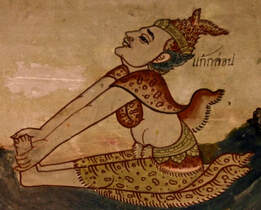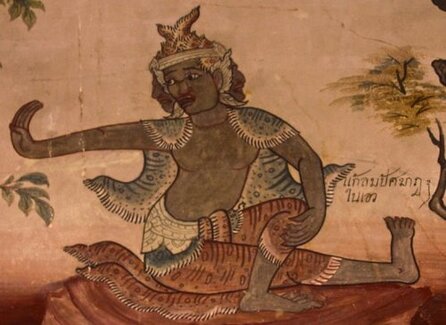GENERAL BACKGROUND
|
Reusi Dat Ton - RDT - has made an appearance in the West. This very deep powerful practice should - dare I say MUST - be studied with under a QUALIFIED teacher / practitioner. Unfortunately many people who "teach" RDT are coming at it from a viewpoint that incorporates the commercial watered-down yoga market we see today. Please take caution because practicing RDT with a superficial understanding - nevermind incorrect understanding - will lead to physical harm. For a comprehensive look at the history and a thorough explanation of Reusi Dat Ton, contact the USA's foremost scholar of RDT, David Wells.
Again, this page is NOT meant to replace a living-breathing teacher. Find your teacher and go study with them. |
I was taught that yoga should be viewed through the lens of its own system. If I am to compare RDT to any other system, that would be the Himalayan Yoga-Āsana system, modality, and tradition. Though there are some differences, RTD can really only be understood holistically when one understands both BuddhaDharma and the traditional medical theory / system of medicine of Thailand. Therein is when the pieces really come together.
Traditionally there are five parts to Reusi Dat Ton:
1. Breathing
2. Self-massage
3. Postures
4. Chanting
5. Visualization and Meditation
Traditionally there are five parts to Reusi Dat Ton:
1. Breathing
2. Self-massage
3. Postures
4. Chanting
5. Visualization and Meditation
BREATHWORK:
THE MOST VITAL ELEMENT
Breath plays the key role, and must be both properly understood and efficiently practiced first. There seems to be a lot of discrepancy about how to breath while practicing Reusi Dat Ton. In Chiang Mai, some teach - at least in 2013 - the practitioner to inhale into the belly then press the air inwards as if performing an उड्डियान बंध Uḍḍiyāna Bandha at the top of the inhalation!?!! Some instructors teach to inhale into the chest cavity. There is a wide variety of information out there. WATCH OUT!
My RDT mentor, an ordained Reusi, teaches that one properly practices breathwork by drawling air into the belly, particularly the lower belly. By using the inhale into the belly, there is a downward force. To create an upward force to wholly support this 'container' in the belly, one steadily lifts the anus / rectum upwards. This is also known as "Vase Breathing".
By practicing that technique, one becomes familiar with using the breath to create and expand internal space. I was instructed that the breath can go into the belly, to the hips, the kidneys, and up the back to the shoulders. However, the breath should never be taken into the chest cavity. By doing so, one is compressing all of the organs in the chest, especially the heart, which is dangerous and leads to injury, dis-ease, or worse.
As a rough general statement, when practicing Reusi Dat Ton one will practice basic breathing:
1. Breathing into the belly, gently lifting just the anus/rectum. Containing the wind in the abdomen.
2. Retaining the inhalation while going through a specific dynamic stretch.
3. Holding, safely, the stretch at your fullest present potential while still holding the breath in.
4. Exhaling to release and return to starting position.
The principle is that by trapping the ลม 'lom' wind - element for / of 'movement' - within the abdomen AND THEN performing a dynamic posture, the internal wind is forced to run through the posture/dynamic movement's corresponding inner channels and assist in better circulation-mobility-flexibility-strength. This is via blowing through and removing any blockages therein. It is an internal form of cleansing and also offers some of the effects of a massage. A pocket of air is formed to allow a ground for the connective tissue, muscles, and bones to move from internally.
My RDT mentor, an ordained Reusi, teaches that one properly practices breathwork by drawling air into the belly, particularly the lower belly. By using the inhale into the belly, there is a downward force. To create an upward force to wholly support this 'container' in the belly, one steadily lifts the anus / rectum upwards. This is also known as "Vase Breathing".
By practicing that technique, one becomes familiar with using the breath to create and expand internal space. I was instructed that the breath can go into the belly, to the hips, the kidneys, and up the back to the shoulders. However, the breath should never be taken into the chest cavity. By doing so, one is compressing all of the organs in the chest, especially the heart, which is dangerous and leads to injury, dis-ease, or worse.
As a rough general statement, when practicing Reusi Dat Ton one will practice basic breathing:
1. Breathing into the belly, gently lifting just the anus/rectum. Containing the wind in the abdomen.
2. Retaining the inhalation while going through a specific dynamic stretch.
3. Holding, safely, the stretch at your fullest present potential while still holding the breath in.
4. Exhaling to release and return to starting position.
The principle is that by trapping the ลม 'lom' wind - element for / of 'movement' - within the abdomen AND THEN performing a dynamic posture, the internal wind is forced to run through the posture/dynamic movement's corresponding inner channels and assist in better circulation-mobility-flexibility-strength. This is via blowing through and removing any blockages therein. It is an internal form of cleansing and also offers some of the effects of a massage. A pocket of air is formed to allow a ground for the connective tissue, muscles, and bones to move from internally.
WHAT IS A ฤาษี REUSI?

The word Reusi (alternate spelling as Ruesi) is the Thai pronunciation of the word ऋषि Rishi, referenced in Indian history as the 'seers', sages and mystics. Rishis very well may have travelled south and east from India to the Indochina peninsula, if they weren't already practicing there from long long ago. Often Reusi are depicted with long beards, crazy teeth, a mala around their necks, and wearing tiger skin clothing. They were considered the keepers of knowledge and the scientists of the spiritual sciences; e.g. medicine, spiritual practices, divination, math, dance, warfare, etc. Reusi are given credit as a vital part to the culture and history of both Siam and modern Thailand.
THE MINISTRY OF PUBLIC HEALTH'S 15 POSTURE FLOW. NARRATED IN THAI.
The story behind these 15-21 poses (depending on how one counts) varies. The Ministry of Public Health 'controls' what legally is and is not Thai Medicine these days. In an effort to help promote and expose the public to traditional exercises that have more Thai history associated with them - rather than yoga from India (or America), and Tai Chi from China - they came up with this little Reusi Dat Ton flow. Supposedly they wanted to make it accessible and so that it could be done by people young, middle aged, and elderly.
These 15 poses are a vignette, which link together and can be done in a relatively short time depending on how many reps of each pose one chooses to perform. Of course, one should consult and request more information from a teacher - and/or doctor - before starting them up. Although seemingly simple, there is a lot of depth to them should one really get into it.
For now, I feel as though these offer some good expose to the beginning steps of the practice.
These 15 poses are a vignette, which link together and can be done in a relatively short time depending on how many reps of each pose one chooses to perform. Of course, one should consult and request more information from a teacher - and/or doctor - before starting them up. Although seemingly simple, there is a lot of depth to them should one really get into it.
For now, I feel as though these offer some good expose to the beginning steps of the practice.
|
|
|

